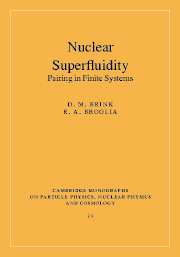Book contents
- Frontmatter
- Contents
- Preface
- 1 Introduction
- 2 The pairing force and seniority
- 3 The BCS theory
- 4 Spontaneous symmetry breaking
- 5 Pairing vibrations
- 6 Phase transitions
- 7 Plastic behaviour of nuclei and other finite systems
- 8 Sources of pairing in nuclei
- 9 Beyond mean field
- 10 Induced interaction
- 11 Pairing in exotic nuclei
- Appendix A A brief résumé of second quantization
- Appendix B Single particle in a non-local potential
- Appendix C Useful relations in the treatment of collective modes
- Appendix D Particle-vibration coupling
- Appendix E Model of the single-particle strength function
- Appendix F Simple model of Pauli principle corrections
- Appendix G Pairing mean-field solution
- Appendix H Pairing in a single j-shell
- Appendix I Fluctuations and symmetry restoration
- Appendix J RPA solution of the pairing Hamiltonian
- Appendix K Vortices in nuclei
- Appendix L Josephson effect
- References
- Index
2 - The pairing force and seniority
Published online by Cambridge University Press: 17 August 2009
- Frontmatter
- Contents
- Preface
- 1 Introduction
- 2 The pairing force and seniority
- 3 The BCS theory
- 4 Spontaneous symmetry breaking
- 5 Pairing vibrations
- 6 Phase transitions
- 7 Plastic behaviour of nuclei and other finite systems
- 8 Sources of pairing in nuclei
- 9 Beyond mean field
- 10 Induced interaction
- 11 Pairing in exotic nuclei
- Appendix A A brief résumé of second quantization
- Appendix B Single particle in a non-local potential
- Appendix C Useful relations in the treatment of collective modes
- Appendix D Particle-vibration coupling
- Appendix E Model of the single-particle strength function
- Appendix F Simple model of Pauli principle corrections
- Appendix G Pairing mean-field solution
- Appendix H Pairing in a single j-shell
- Appendix I Fluctuations and symmetry restoration
- Appendix J RPA solution of the pairing Hamiltonian
- Appendix K Vortices in nuclei
- Appendix L Josephson effect
- References
- Index
Summary
Evidence for pairing correlations
The nucleus 208Pb is well described by the independent particle model in terms of closed shells in both neutrons and protons. The absence of low-lying states supports this hypothesis. The shell model would then describe the low-lying levels of 207Pb in terms of the states of a single neutron hole. The observed energies, angular momenta and parities are in good accord with this picture, although small admixtures of more complicated configurations must be invoked to account for some fast electromagnetic decays (see Sections 9.1 and 9.2). The next step is to interpret the levels of 206Pb in terms of two holes, which are combinations of the single-hole states of 207Pb, interacting through a residual interaction. The dramatic effect of the internucleon force is shown by the fact that there is only one excited state below 1.2 MeV, compared with the five we would get in the independent hole approximation (see Fig. 2.1). This becomes even more striking in 204Pb, where the independent hole picture predicts about thirty levels within 1 MeV of the ground state, whereas again only one is observed (Mottelson (1996)).
Another indication of the importance of the residual interaction among nucleon pairs is the well-known difference in physical properties between even and odd nuclei. For example, studies of cosmic abundances show that nuclei with even proton and neutron numbers are much more abundant, and thus more stable, indicating stronger binding energies.
- Type
- Chapter
- Information
- Nuclear SuperfluidityPairing in Finite Systems, pp. 33 - 51Publisher: Cambridge University PressPrint publication year: 2005



